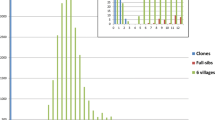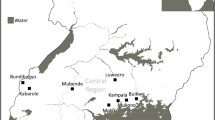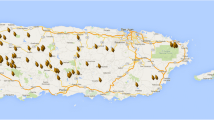Abstract
Taro (Colocasia esculenta (L.) Schott), cultivated in Vêtuboso, a village of northern Vanuatu, Melanesia, was surveyed to: (1) assess the extent of morphological and molecular variation being maintained by growers at the village level and, (2) compare this diversity with the diversity found in the crops in Vanuatu. Ethnobotanical data were combined with AFLP analysis to elucidate possible sources of variation. Folk assessment of variation is based on: (a) morphological characteristics (11 characters), (b) names and (c) classification according to habitat, uses, origin and agronomic adaptation. This 3-fold approach allowed growers to differentiate 96 morphotypes, all of which are given distinct vernacular names. AFLP fingerprints successfully differentiated all these 96 morphotypes which do not present a significant intra-clonal variation. But genetic results showed no clear groupings according to geographic origin or habitat of morphotypes and stated that the diversity found within the village was comparable with the overall diversity found in Vanuatu. Local nomenclature and stories associated with each cultivar suggested three sources of diversity: introductions (38%), somatic mutations (15%) and sexual recombinations (48%). AFLP results confirm folk beliefs about origin at least for three pairs of mutants. The 11 so-called wild forms analysed by AFLP were suggested to be feral, escapes from domestication. A dynamic in situ conservation strategy (DISC), favouring a broadening of the national genetic base, was discussed for taro.
Similar content being viewed by others
References
Bulmer R. (1965). Beliefs concerning the propagation of new varieties of sweet potato in two New Guinea Highlands societies. J. Polyn. Soc. 74(2): 237–239
Caillon S. and Lanouguère-Bruneau V. 2005. Gestion de l’agrobiodiversité dans un village de Vanua Lava (Vanuatu): stratégies de sélection et enjeux sociaux. J.S.O. (120)1.
Caillon S., Quero-García J. and Guarino L. (2004). Taro in Vanuatu: towards a dynamic conservation strategy. LEISA 20(1): 18–20
Coates D.J., Yen D.E. and Gaffey P.M. (1988). Chromosome variation in taroColocasia esculenta. Implications for origin in the Pacific. Cytologia 53: 551–560
Conklin H. (1962). Lexicographical treatment of the folk taxonomies. In: Householder, F.W. and Saporta, S. (eds) Problems in Lexicography, pp 119–141. Indiana University Research Center in Anthropology, Folklore and Linguistic Publication no. 21, Bloomington, USA
Emperaire L., Pinton F. and Second G. (1998). Gestion dynamique de la diversité variétale du manioc en Amazonie du Nord-Ouest. N.S.S. 6(2): 27–42
Elias M. (2000). Perception and Management of Cassava. J. Ethnobiol 20(2): 239–265
Farmer Support Association (FSA) 1999. In situ conservation of taro. A Feasability Study: Vanuatu. Taro Genetic Resources Project, ACIL, AUSAID, ACIL, AUSAID, Luganville, Vanuatu.
Ghérardi M., Mangin B., Goffinet B., Bonnet D. and Huguet T. (1998). A method to measure genetic distance between allogamous populations of alfalfa (Medicago sativa) using RAPD molecular markers. Theor. Appl. Genet. 96: 406–412
Hess S. 2005. Perceptions of place and concept of the person on Vanua LavaVanuatu. PhD dissertation, Australian. National University.
Ivancic A. (1995). Abnormal and unusual inflorescences of taroColocasia esculenta (Araceae). Aust. J. Bot. 43: 475–489
Ivancic A. and Lebot V. (1999). Botany and genetics of New Caledonian wild taro, Colocasia esculenta. Pacific Sci. 53(3): 273–285
Ivancic A. and Lebot V. (2000). The Genetics and Breeding of Taro. Séries Repéres MAD, Montpellier, France
Ivancic A., Lebot V., Roupsard O., Quero-Garcia J. and Okpul T. (2004). Thermogenic flowering of taro (Colocasia esculenta). Can. J. Bot. 82(11): 1557–1565
Jansen T. (2002). Hidden TaroHidden Talents: A Study of On-farm Conservation of Colocasia esculenta (taro) in Solomon Islands. Solomon Islands Planting Material Network and Kastom Garden Association, Honiara, Solomon Islands
Jones C.J., Edwards K.J., Castaglione S., Winfield M.O., Sala F., de Wiel C., Bredemeijer G., Vosman B., Matthes M., Daly A., Brettschneider R., Bettini P., Buiatti M., Maestri E., Malcevschi A., Marmiroli N., Aert R., Volckaert G., Rueda J., Linacero R., Vazquez A. and Karp A. (1997). Reproducibility testing RAPD, AFLP and SSR markers in plants by network of European laboratories. Mol. Breed. 3: 381–390
Kikuta K., Whitney L.D. and Parris G.K. (1938). Am. J. Bot. 25: 186–188
Kreike C.M. and Lebot V. (2004). Genetic diversity of taro (Colocasia esculenta (L.) Schott) in South-East Asia and Pacific. Theor. Appl. Genet. 109: 761–768
Lebot V. and Aradhya K.M. (1991). Isozyme variation in taro (Colocasia esculenta (L.) Schott) from Asia and Oceania. Euphytica 56: 55–66
Lebot V., Hartati S., Hue N.T., Viet N.V., Nghia N.H., Okpul T., Pardales J., Prana M.S., Prana T.K., Thongjiem M., Krieke C.M., VanEck H., Yap T.C. and Ivancic A. 2000. Genetic variation in taro (Colocasia esculenta) in South East Asia and Oceania. In: Nakatani M. and Komaki K.(eds) Proceedings of the Twelfth Symposium of the ISTRC, TsukubaJapan, September 10–16, 2000, pp. 524–533.
Lebot V., Prana M.S., Kreike N., Pardales J., Okpul T., Gendua T., Thongjiem M., Hue H. and Yap T.C. (2004). Characterisation of taro (Colocasia esculenta (L.) Schott) genetic resources in Southeast Asia and Oceania. Genet. Resour. Crop Evol. 51: 381–392
Lebot V., Trilles B., Noyer J.L. and Modesto J. (1998). Genetic relationships between Discorea alata L. cultivars. Genet. Resour. Crop Evol. 45(6): 499–509
Levi-Strauss C. (1962). La pensée sauvage. Ed. Pion, Paris
Mace E. and Godwin I.D. (2002). Development and characterization of polymorphic microsatellite markers in taroColocasia esculenta (L.) Schott. Genome 45(5): 823–832
Malapa R., Arnau G., Noyer J.L. and Lebot V. 2005. Genetic diversity of the Greater Yam (Dioscorea alata L.) and relatedness to D. nummularia Lam. and D. transversa Br. as revealed with AFLP markers. Genet. Resour. Crop Evol. (in press).
Majnep I.S. and Bulmer R. (1977). Birds of my Kalam Country. Auckland University Press, Auckland, New Zealand
Noyer J.L., Billot C., Weber A., Brottier P., Quero-García J. and Lebot V. 2005. Genetic diversity of taro (Colocasia esculenta (L.) Schott) assessed by SSR markers. In: Guarino L. and Taylor M.(eds) Proceedings of the 3rd International Taro Symposium, SPC-TPGRI-FAO-CIRAD, Nadi, Fiji, 22–24 May, 2003, (in press).
Panoff F. (1972). Maenge Gardens. A Study of Maenge Relationship to Domesticates. Australian National University, Canberra, Australia
Perrier X., Flori A. and Bonnot F. (2001). Methods of data analysis. In: Hamon, P., Seguin, M., Perrier, X., and Glaszmann, J.C. (eds) Genetic Diversity of Cultivated Tropical Plants, pp 31–63. Cirad, Montpellier, France
Prain G., Schneider J. and Widiyastuti C. (2000). Farmers’ maintenance of sweet potato diversity in Irian Jaya. In: Almekinders, C. (eds) Encouraging Diversity. The Conservation and Development of Plant Genetic Resources, pp 54–59. Intermediate Technology Publications Ltd, 362, London
Quero-Garcia J., Noyer J.L., Marchand J.L. and Lebot V. (2004). Germplasm stratification of taro (Colocasia esculenta) based on agro-morphological descriptors. Validation by AFLP markers. Euphytica 137: 387–395
Salick J., Cellinese N. and Knapp S. (1997). Indigenous diversity of cassava: generation, maintenanceuse and loss among the Amuesha, Peruvian Upper Amazon. Econ. Bot. 51(1): 6–19
Shaw D.E. (1975). Illustrated notes on flowering, flowers, seed and germination in taro (Colocasia esculenta (L.) Schott). Port Moresby, Papua New GuineaRes. Bull. Dept. Agric. 13: 39–59
Sokal R.R. and Michener C.D.A. (1958). A statistical method for evaluating systematic relationships. Univ. Kansas Sci. Bull. 38: 1409–1438
Sreekumari M.T. and Thankamma Pillai P.K. (1994). Breeding barriers in taro (Colocasia esculenta (L.) Schott). J. Root Crops 20(1): 20–25
(1994). Vanuatu National Agriculture Census. Main Report. Port Vila, Vanuatu
Yen D.B. (1960). The sweet potato in the Pacific: the propagation of the plant in relation to its distribution. J. Polyn. Soc. 69: 368–375
Weightman B. (1989). Agriculture in Vanuatu. A Historical Review. The British Friends of Vanuatu, Portsmouth
Author information
Authors and Affiliations
Corresponding author
Rights and permissions
About this article
Cite this article
Caillon, S., Quero-Garcia, J., Lescure, JP. et al. Nature of taro (Colocasia esculenta (L.) Schott) genetic diversity prevalent in a Pacific Ocean island, Vanua Lava, Vanuatu. Genet Resour Crop Evol 53, 1273–1289 (2006). https://doi.org/10.1007/s10722-005-3877-x
Received:
Accepted:
Published:
Issue Date:
DOI: https://doi.org/10.1007/s10722-005-3877-x




